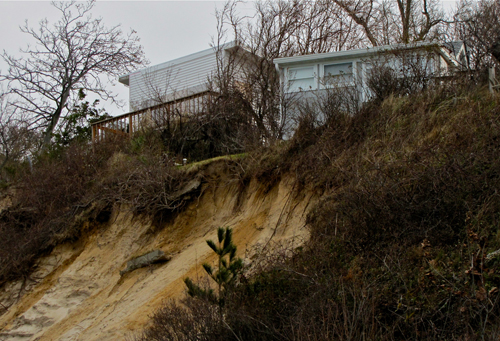Walter: Who’ll fix the North Shore beaches?

But what about the North Shore?
That’s the question Riverhead Town Supervisor Sean Walter and some residents who live along the Long Island Sound are asking, as Hurricane Sandy has erased much of the beach that used to stand between their homes and the water.
“Right now, the mean high water mark is probably in some people’s living rooms,” Mr. Walter said Friday.
“About 70 to 80 feet of beach is just gone,” said Jim Loscalzo, who lives on Creek Road in Wading River.
The beach along Creek Road now is almost up to the houses and bulkheads that have been buried for years are now exposed. In one case, a cesspool ring is visible on the beach.
Mr. Loscalzo, who rode out the storm with his wife, said he lost everything below the first floor of his home, including two cars that flooded.
“We’re very nervous about this situation,” said Ginnie Grieco of Oak Street in Wading River, which is just east of the town beach there. “The storm took most of our beach away.”
Ms. Grieco is planning to initiate a petition drive to get the federal government to rebuilt the beach, much like it’s doing on the South Shore.
“I see them giving a billion dollars to help the South Shore, but why not the North Shore?” she asked. “Right now, high tide is almost in my living room.”
Other areas along the Sound in Riverhead Town also have seen significant erosion since Sandy. The water along the beach at the end of Hulse Landing Road is now right up to the house on the westerly corner of the road, and almost up to the bluffs on the east. Houses on the top of those bluffs are now perilously close to the edge.
At the end of Edwards Avenue in Calverton, the water is also right up to the base of beachfront homes.
Mr. Walter said he attended a Long Island Association breakfast Friday morning at which state Department of Environmental Conservation commissioner Joe Martens spoke on the subject of Hurricane Sandy.
Mr. Walter said he asked the commissioner if there was a way the state or federal government could initiate a project to rebuild the badly eroded Sound beaches by dredging sand from bottom offshore and pumping onto the beach.
He said Mr. Martens told him they’d look into it.
The supervisor said he’s also been in contact with Congressman Tim Bishop’s office.
Oliver Longwell, an aide to Mr. Bishop, said Friday that the process that led to the South Shore projects is different from what would apply to Sound beaches.
“Those are beaches that are managed by the federal government, so that is something the Army Corp has funds already appropriated for, from Fire Island to Montauk Point,” Mr. Longwell said.
On the Sound beaches, he said, Riverhead Town would have to initiate a beach restoration project on its own, and seek reimbursement from the federal government.
He said the town would know in advance if a federal appropriations bill with money for such projects had been approved.
The federal government also will need to provide help by exempting certain projects from standing dredging deadlines. Dredging is usually prohibited during winter flounder and piping plover mating seasons.
Mr. Walter said he understands that the ocean barrier beaches need to be restored, but the North Shore needs help too.
“It’s a mess along the Sound, and we’re trying to get the attention of the powers that be to address it, because if I dredge a little bit of sand out of Wading River Creek, we might be able to help a few homeowners, but we’re not going to be able to do what needs to be done,” Mr. Walter said.
“What we really need is an offshore dredge to come in and dredge the sand out of the Sound and then put it up on the beach.”
And that type of project is expensive, he added.
Even when the Federal Emergency Management Agency (FEMA) provides assistance, the town still must pay 25 percent of the cost.
“If you’re talking about tens of millions of dollars, and the town had to pay 25%, we wouldn’t be able to do it,” Mr. Walter said. “We want to see if we can get them to do it.”
Mr. Loscalzo said that when he bought his property in the mid-1980s the beach along Creek Road looked much like it does now with stairs leading down to the beach. Over the years, the Long Island Lighting Company, LIPA’s predecessor, raised the beach by pumping sand onto it from when it dredged Wading River Creek.
“This storm, in 8 or 9 hours, destroyed everything that’s been done down here,” he said.
He said he rode out Hurricane Gloria in 1985 too, and he thinks Sandy was much worse.
“Sandy made Gloria seem like a wind storm,” he said. “My wife and I stood on our deck and watched telephone poles and boats and everything floating by.”
The town has begun to receive applications from beachfront homeowners seeking to rebuild their bulkheads damaged in the storm, and Mr. Walter said he hopes to have a system in place to expedite those applications.








